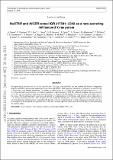| dc.contributor.author | Sanna, A. | |
| dc.contributor.author | Ferrigno, C. | |
| dc.contributor.author | Ray, P. S. | |
| dc.contributor.author | Ducci, L. | |
| dc.contributor.author | Jaisawal, G. K. | |
| dc.contributor.author | Enoto, T. | |
| dc.contributor.author | Bozzo, E. | |
| dc.contributor.author | Altamirano, D. | |
| dc.contributor.author | Di Salvo, T. | |
| dc.contributor.author | Strohmayer, T. E. | |
| dc.contributor.author | Papitto, A. | |
| dc.contributor.author | Riggio, A. | |
| dc.contributor.author | Burderi, L. | |
| dc.contributor.author | Bult, P. M. | |
| dc.contributor.author | Bogdanov, S. | |
| dc.contributor.author | Gambino, A. F. | |
| dc.contributor.author | Marino, A. | |
| dc.contributor.author | Iaria, R. | |
| dc.contributor.author | Arzoumanian, Z. | |
| dc.contributor.author | Gendreau, K. C. | |
| dc.contributor.author | Guillot, S. | |
| dc.contributor.author | Markwardt, C. | |
| dc.contributor.author | Wolff, M. T. | |
| dc.contributor.author | Chakrabarty, Deepto | |
| dc.date.accessioned | 2019-03-18T14:42:41Z | |
| dc.date.available | 2019-03-18T14:42:41Z | |
| dc.date.issued | 2018-09 | |
| dc.date.submitted | 2018-08 | |
| dc.identifier.issn | 0004-6361 | |
| dc.identifier.issn | 1432-0746 | |
| dc.identifier.uri | http://hdl.handle.net/1721.1/121008 | |
| dc.description.abstract | We report the discovery by the Nuclear Spectroscopic Telescope Array (NuSTAR) and the Neutron Star Interior Composition Explorer (NICER) of the accreting millisecond X-ray pulsar IGR J17591-2342. Coherent X-ray pulsations around 527.4 Hz (1.9 ms) with a clear Doppler modulation were detected. This implies an orbital period of ∼8.8 h and a projected semi-major axis of ∼1.23 lt-s. With the binary mass function, we estimate a minimum companion mass of 0.42 M, obtained assuming a neutron star mass of 1.4[subscript ⊙] and an inclination angle lower than 60°, as suggested by the absence of eclipses or dips in the light curve of the source. The broad-band energy spectrum, obtained by combining NuSTAR, swift and INTEGRAL observations, is dominated by Comptonisation of soft thermal seed photons with a temperature of ∼0.7 keV by electrons heated to 21 keV. We also detect black-body-like thermal direct emission that is compatible with an emission region of a few kilometers and a temperature compatible with the seed source of Comptonisation. A weak Gaussian line centred on the iron Kα complex can be interpreted as a signature of disc reflection. A similar spectrum characterises the NICER spectra, which was measured when the outburst faded. Key words: accretion, accretion disks / stars: low-mass / pulsars: general / stars: neutron / X-rays: binaries | en_US |
| dc.description.sponsorship | United States. National Aeronautics and Space Administration | en_US |
| dc.publisher | EDP Sciences | en_US |
| dc.relation.isversionof | http://dx.doi.org/10.1051/0004-6361/201834160 | en_US |
| dc.rights | Creative Commons Attribution-Noncommercial-Share Alike | en_US |
| dc.rights.uri | http://creativecommons.org/licenses/by-nc-sa/4.0/ | en_US |
| dc.source | arXiv | en_US |
| dc.title | NuSTAR and NICER reveal IGR J17591–2342 as a new accreting millisecond X-ray pulsar | en_US |
| dc.type | Article | en_US |
| dc.identifier.citation | Sanna, A., C. Ferrigno, P. S. Ray, L. Ducci, G. K. Jaisawal, T. Enoto, E. Bozzo, et al. “NuSTAR and NICER Reveal IGR J17591–2342 as a New Accreting Millisecond X-Ray Pulsar.” Astronomy & Astrophysics 617 (September 2018): L8. © 2018 ESO 2018 | en_US |
| dc.contributor.department | Massachusetts Institute of Technology. Department of Physics | en_US |
| dc.contributor.mitauthor | Chakrabarty, Deepto | |
| dc.relation.journal | Astronomy & Astrophysics | en_US |
| dc.eprint.version | Original manuscript | en_US |
| dc.type.uri | http://purl.org/eprint/type/JournalArticle | en_US |
| eprint.status | http://purl.org/eprint/status/NonPeerReviewed | en_US |
| dc.date.updated | 2019-03-12T15:15:12Z | |
| dspace.orderedauthors | Sanna, A.; Ferrigno, C.; Ray, P. S.; Ducci, L.; Jaisawal, G. K.; Enoto, T.; Bozzo, E.; Altamirano, D.; Di Salvo, T.; Strohmayer, T. E.; Papitto, A.; Riggio, A.; Burderi, L.; Bult, P. M.; Bogdanov, S.; Gambino, A. F.; Marino, A.; Iaria, R.; Arzoumanian, Z.; Chakrabarty, D.; Gendreau, K. C.; Guillot, S.; Markwardt, C.; Wolff, M. T. | en_US |
| dspace.embargo.terms | N | en_US |
| dc.identifier.orcid | https://orcid.org/0000-0001-8804-8946 | |
| mit.license | OPEN_ACCESS_POLICY | en_US |
